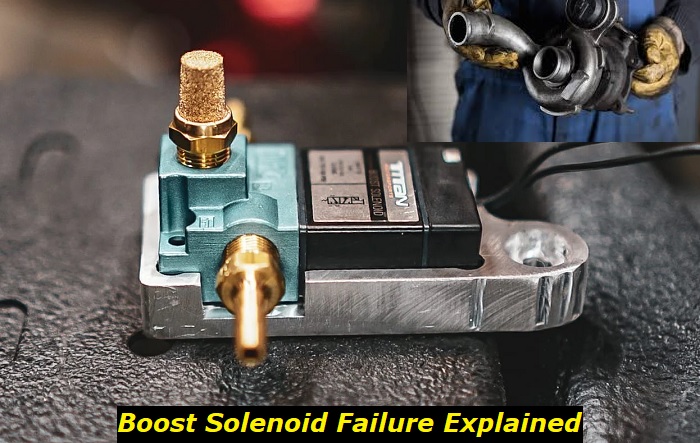When the boost solenoid fails in your vehicle, what happens is that your car will no longer be producing sufficient boost. Sometimes, you may experience a boost fluctuation, boost spikes, stalling, and poor engine performance. Other symptoms of a bad boost solenoid include poor fuel economy, illuminated check engine light, and stored error code.
Turbo problems highlights
- Level of importance:Medium
- Commonreasons:Mileage, age, poor lubrication, internal damage, aggressive use
- DIY inspection:Possible but may be complicated
- DIY repair:Sometimes, possible
- Price for repair:$350 - $800
- Can you drive?In most cases, yes
- Ways to fix:Replace the parts thatare diagnosedto be faulty

What is a boost solenoid?
For a better understanding of the function of the boost solenoid, we will briefly talk about the boost control system in a turbocharged engine.
Turbochargers use engine exhaust fumes/gases to spin up a turbine wheel that is mounted on a common shaft with a compressor wheel. The compressor wheel is responsible for absorbing fresh air from the air filter to create what we know as boost pressure.
Boost pressure plays an important role in creating more engine power. That is, the more compressed the intake air is, the denser the air becomes, the more power the engine can produce.
However, you can't just create more engine power by increasing the boost pressure in the engine. You need to regulate the speed of the turbine by bypassing exhaust gasses around the exhaust turbine wheel with a component known as the wastegate. The wastegate helps to regulate the exhaust gases to make sure the turbine doesn't overspin and cause catastrophic damage.
The boost solenoid is used to manipulate or "bleed off" boost pressure that the wastegate receives. The more pressure is bled off, the more exhaust gasses the wastegate will direct into the turbine wheel to generate more boost pressure.
What are the common causes of a failing boost solenoid?
The following are some of the common causes of a boost solenoid failure:
1) Worn-out boost solenoid
Boost solenoids will usually fail as they wear and tear with age. Typically, a boost solenoid will last for about 30,000 miles. They tend to leak vacuums when they fail, which causes reduced boost pressure. The diaphragm of the solenoids is unable to completely seal and allows pressure to leak away.
2) Broken hose
It is possible that the hose connected to either port A or B of the boost solenoid is damaged and leaks off boost pressure. In this case, you will need to have the hose replaced.
3) Clogged Passage
Carbon buildup, particles, or debris may accumulate within the solenoid passage or its lines, reducing the boost pressure that it can produce.
4) Electrical issues
The boost solenoid is an electrical device that relies on a sufficient voltage supply. It is possible that the terminals, and wiring connections or components are damaged preventing the solenoid from working properly.
Symptoms of a failing boost solenoid (350)
A failing boost solenoid comes with clear signs that affect the drivability of your turbo-charged engine. The following are some of the common symptoms associated with a failing boost solenoid:
1) Reduced boost pressure
When the boost solenoid fails, it is unable to open or close as required for boost control. This disruption in its operation means that it cannot regulate the wastegate supply of exhaust fumes and subsequently boost pressure. For instance, a closed solenoid means that air is restricted from the wastegate actuator, causing the turbocharger to produce less boost as needed.
2) Boost spikes/fluctuation
A bad or faulty boost solenoid may cause it to have an inconsistent duty cycle, which the ECU relies on. This means that the solenoid valves may open and close too frequently, causing a spike or fluctuation in boost pressure.
3) Poor fuel Economy
A failed boost solenoid has been reported to cause poor fuel economy in many cars. The inability of the boost solenoid to control the wastegate means that it may over-boost, sometimes causing excessive fuel consumption and bad mileage.
4) Check engine warning light
Check engine light will be triggered once there is a mechanical fault with the car. The solenoid boost sensor is programmed to inform the ECU once there is a deviation from the normal threshold. Once this happens, the check engine warning light will be triggered. However, the check engine light should not be solely relied on for symptoms of bad solenoid boost.
5) Stored Error Code
Your vehicle may store error codes related to a faulty boost solenoid. Some of these codes include; P0047 (Turbo Charger Boost Control Solenoid Circuit Low), P0243 (Turbocharger Wastegate Solenoid A Malfunction), P0045 (Turbo/Super Charger Boost Control Solenoid Circuit/Open), and P2563 (Turbocharger Boost Control Position Sensor Circuit Range/Performance).
How do you remedy a bad boost solenoid?
Fixing a bad boost solenoid will involve first identifying the cause of the fault. Earlier, we have identified some of the causes that I have come across during my work on turbochargers. Here are some steps to remedy a bad boost solenoid:
1. Visual inspection: Inspect your solenoid for physical damages, clogged passages, or broken lines.
2. Clean or replace the boost solenoid: After physically inspecting the solenoid, proceed to clean the passage and lines in case of accumulated debris and carbon buildup. If the solenoid is broken, replace it with a manufacturer-recommended brand.
3. Fix wiring or connection issues: Identify any broken wiring or terminals and replace them. Also, replace or repair any electrical components that may affect the operation of the solenoid.
4. Inspect for Vacuum leaks: Check the hose/lines for vacuum leaks from both ports A and B
How to test a boost solenoid for failure?
There are a couple of ways to test your Boost Control Solenoid if you suspect it has failed. Here, I'll teach you how to test your boost solenoid using a multimeter tool, vacuum test, and voltage test. It is worth noting that these methods will work for all turbo-charged vehicles regardless of the brand of control solenoid employed.
1) Multimeter test for boost solenoid
For this test, you will need a multimeter and a test lead. Most solenoid boost controls have a measurement of 28??2 (at 20°C), but you should check the manufacturer's specification for clarity.
First, ensure that your multimeter is set to ohms measurement. This is usually indicated with this sign ?. Also, make sure that the test lead (red and black wires) are connected to the multimeter and that they are working. You can do this by touching the metal lead for reaction.
Next, connect each lead to the terminal of the boost solenoid. They should read 28??2; anything too high or low indicates an issue with the Boost solenoid.
2) Vacuum test for boost solenoid
The vacuum test involves checking for vacuum leaks from port B of the solenoid control. For this test, you need to check that port B isn't leaking air by blowing air into port A. Follow the steps below for this process:
While no power is supplied to the solenoid, blow air into port A of the solenoid.
To blow air, use an air compressor and set at min: 2 psi and max: 6 psi.
There should be no leakage from port B. Any leakage shows that the solenoid has failed and will need to be replaced.
3) Voltage test for boost solenoid
This test involves carrying out the vacuum test while applying a voltage to the boost solenoid. However, each test aims to achieve a different objective. The voltage test wants to check that port A opens to port B when a boost is applied.
For this test, you will need a 12V battery and an air compressor. Another way to check that the solenoid is still working is that when the voltage is applied, you should hear a click sound from the boost solenoid.
Conclusion
A functioning boost control is vital for the optimal performance of turbocharged engines. They help to regulate the boost pressure by regulating the pressure from the wastegate actuator. By identifying some of the common symptoms of a failing solenoid, I hope our readers can properly diagnose, test, and fix a failing boost solenoid. It is important that the boost solenoid is changed between 30,000 and 50,000 miles depending on how the vehicle is being used.
About the authors
The CarAraC research team is composed of seasoned auto mechanics and automotive industry professionals, including individuals with advanced degrees and certifications in their field. Our team members boast prestigious credentials, reflecting their extensive knowledge and skills. These qualifications include: IMI: Institute of the Motor Industry, ASE-Certified Master Automobile Technicians; Coventry University, Graduate of MA in Automotive Journalism; Politecnico di Torino, Italy, MS Automotive Engineering; Ss. Cyril and Methodius University in Skopje, Mechanical University in Skopje; TOC Automotive College; DHA Suffa University, Department of Mechanical Engineering






Add comment